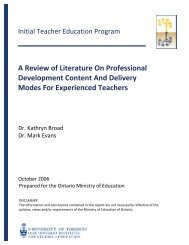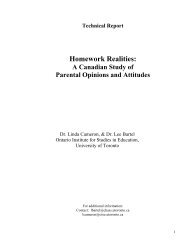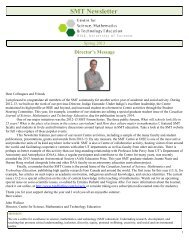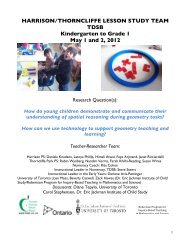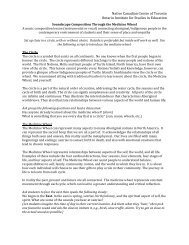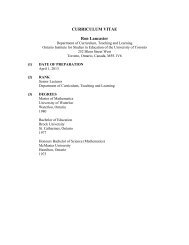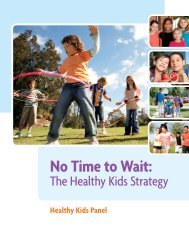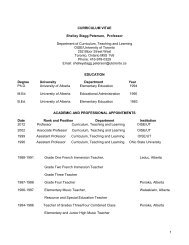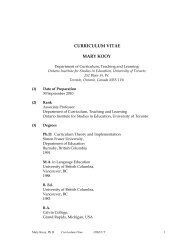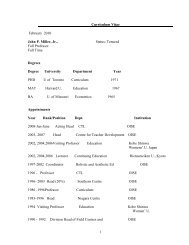The Ontario Curriculum, Grades 9-12 - Ministère de l'éducation ...
The Ontario Curriculum, Grades 9-12 - Ministère de l'éducation ...
The Ontario Curriculum, Grades 9-12 - Ministère de l'éducation ...
Create successful ePaper yourself
Turn your PDF publications into a flip-book with our unique Google optimized e-Paper software.
ecological footprint. Many experts believe that we are consuming more resources each<br />
year than Earth can produce.<br />
Sample questions: How does the Living Planet In<strong>de</strong>x (LPI) help a nation to assess its<br />
ecological footprint and sustain its population? How does the planned obsolescence of<br />
electronic <strong>de</strong>vices and appliances contribute to our ecological footprint? What impact has<br />
rapid population growth into the suburbs had on the local environment? What is the<br />
environmental impact of using packaged infant formula instead of breastfeeding a baby<br />
for the first six months of life?<br />
F1.2 assess, on the basis of research, the effectiveness of some Canadian technologies and<br />
projects inten<strong>de</strong>d to nourish expanding populations (e.g., the risks and benefits of<br />
growing genetically modified canola; some of the sustainable <strong>de</strong>velopment projects<br />
fun<strong>de</strong>d by the Canadian International Development Agency [CIDA]) [IP, PR, AI, C]<br />
Sample questions: How are Canadian programs helping to reverse the effects of land<br />
<strong>de</strong>gradation and promote sustainable farming in semi-arid and dry sub-humid areas?<br />
What is Canada’s role in the Flour Fortification Initiative, and how effectively does this<br />
initiative meet its goal of nourishing expanding populations?<br />
F2. Developing Skills of Investigation and Communication<br />
F2. investigate the characteristics of population growth, and use mo<strong>de</strong>ls to calculate the<br />
growth of populations within an ecosystem;<br />
F2.3 <strong>de</strong>termine, through laboratory inquiry or using computer simulations, the characteristics of<br />
population growth of two different populations (e.g., the different population cycles of a<br />
predator and its prey; the population cycles of two populations that compete for food; …)<br />
[PR, AI, C]<br />
F3. Un<strong>de</strong>rstanding Basic Concepts<br />
F3.5 explain how a change in one population in an aquatic or terrestrial ecosystem can affect<br />
the entire hierarchy of living things in that system (e.g., how the disappearance of<br />
crayfish from a lake causes a <strong>de</strong>crease in the bass population of the lake; how the<br />
disappearance of beaver from an ecosystem causes a <strong>de</strong>crease in the wolf population in<br />
that ecosystem)<br />
CHEMISTRY<br />
Chemistry, Gra<strong>de</strong> 11, University Preparation (SCH3U)<br />
A. Scientific Investigation Skills and Career Exploration<br />
A2. Career Exploration<br />
A2.1 i<strong>de</strong>ntify and <strong>de</strong>scribe a variety of careers related to the fields of science un<strong>de</strong>r study (e.g.,<br />
pharmacist, forensic scientist, chemical engineer, food scientist, environmental chemist,<br />
occupational health and safety officer, water quality analyst, atmospheric scientist) and<br />
the education and training necessary for these careers<br />
118 Environmental Education, <strong>Gra<strong>de</strong>s</strong> 9−<strong>12</strong>: Scope and Sequence of Expectations, 2011



